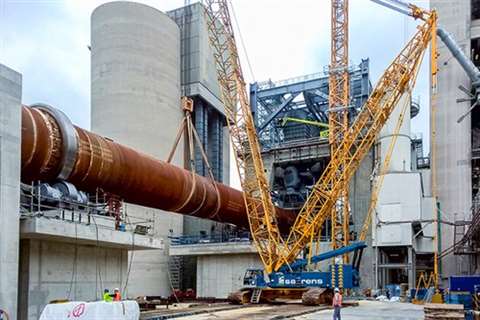Heidelberg Cement job in Germany
14 May 2018
Sarens took on a kiln exchange project at Heidelberg Cement in Germany

Sarens was contracted by the AG cement works in Schelklingen, Baden-Württemberg, Germany, to replace its two existing rotary kilns with a new one weighing 144 tonnes and measuring 5 metres in diameter.
As an energy-intensive company, HeidelbergCement AG has made substantial efforts to minimise its carbon dioxide emissions. As part of this initiative it replaced the existing rotary cement kilns with more technologically advanced units that emit less carbon dioxide.
Sarens team was entrusted with the responsibility of hoisting the five components of the 68 m rotary kiln up to a height of 11 m in a restricted space. The challenge was to figure out a solution which could be assembled in a small space, lift a weight of 144 tonnes and is compact enough to operate in that given space.
The engineering and operation team decided to deploy the 350 tonne capacity Liebherr LR 1350-1 with a 42 metre main boom, 27 metre derrick boom, as well as 85 tonnes of superstructure ballast and 75 tonnes of suspended ballast. It took 20 trucks to transport the lattice boom crane which was assembled in three days using an auxiliary 70 tonne telescopic crane. The biggest difficulty was the very limited space; three tower cranes working in the vicinity as well as a working rotary kiln next to the crane. Project Manager, Bram Van Overwalle said, “Due to the restricted space, we had to engineer every single movement of the crane beforehand. During execution, the crane operator needed to follow all instructions very precisely because we needed all the space we had.”
Once assembled, the Sarens team performed the lift of seven pipe sections of a rotary kiln which were assembled by our client ‘Duro Dakovic Montaza d.o.o.’ & Thyssen-Krupp. The seven pieces together formed a cement rotary kiln with a diameter of approximately 5 metres. The biggest load we had to lift was a kiln segment of 144 tonnes for which the team used an additional 75 tonnes of suspended ballast above the normal crane ballast. The challenge during this lift was the very limited rotation space with the suspended ballast so the team precisely combined slewing and crawling to get into the right position and safely execute the lift.
Regional sales manager Germany, Maarten Joost de Korte, remarks, “Attributable to our good preparation and engineering work before, our customer was very pleased with our performance. All lifts went as scheduled.”




